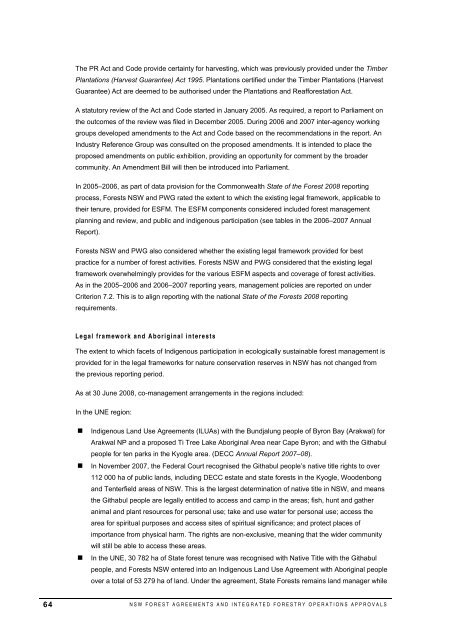Progress Report 2007-2008 - Department of Environment and ...
Progress Report 2007-2008 - Department of Environment and ...
Progress Report 2007-2008 - Department of Environment and ...
You also want an ePaper? Increase the reach of your titles
YUMPU automatically turns print PDFs into web optimized ePapers that Google loves.
64<br />
The PR Act <strong>and</strong> Code provide certainty for harvesting, which was previously provided under the Timber<br />
Plantations (Harvest Guarantee) Act 1995. Plantations certified under the Timber Plantations (Harvest<br />
Guarantee) Act are deemed to be authorised under the Plantations <strong>and</strong> Reafforestation Act.<br />
A statutory review <strong>of</strong> the Act <strong>and</strong> Code started in January 2005. As required, a report to Parliament on<br />
the outcomes <strong>of</strong> the review was filed in December 2005. During 2006 <strong>and</strong> <strong>2007</strong> inter-agency working<br />
groups developed amendments to the Act <strong>and</strong> Code based on the recommendations in the report. An<br />
Industry Reference Group was consulted on the proposed amendments. It is intended to place the<br />
proposed amendments on public exhibition, providing an opportunity for comment by the broader<br />
community. An Amendment Bill will then be introduced into Parliament.<br />
In 2005–2006, as part <strong>of</strong> data provision for the Commonwealth State <strong>of</strong> the Forest <strong>2008</strong> reporting<br />
process, Forests NSW <strong>and</strong> PWG rated the extent to which the existing legal framework, applicable to<br />
their tenure, provided for ESFM. The ESFM components considered included forest management<br />
planning <strong>and</strong> review, <strong>and</strong> public <strong>and</strong> indigenous participation (see tables in the 2006–<strong>2007</strong> Annual<br />
<strong>Report</strong>).<br />
Forests NSW <strong>and</strong> PWG also considered whether the existing legal framework provided for best<br />
practice for a number <strong>of</strong> forest activities. Forests NSW <strong>and</strong> PWG considered that the existing legal<br />
framework overwhelmingly provides for the various ESFM aspects <strong>and</strong> coverage <strong>of</strong> forest activities.<br />
As in the 2005–2006 <strong>and</strong> 2006–<strong>2007</strong> reporting years, management policies are reported on under<br />
Criterion 7.2. This is to align reporting with the national State <strong>of</strong> the Forests <strong>2008</strong> reporting<br />
requirements.<br />
Legal framework <strong>and</strong> Aboriginal interests<br />
The extent to which facets <strong>of</strong> Indigenous participation in ecologically sustainable forest management is<br />
provided for in the legal frameworks for nature conservation reserves in NSW has not changed from<br />
the previous reporting period.<br />
As at 30 June <strong>2008</strong>, co-management arrangements in the regions included:<br />
In the UNE region:<br />
Indigenous L<strong>and</strong> Use Agreements (ILUAs) with the Bundjalung people <strong>of</strong> Byron Bay (Arakwal) for<br />
Arakwal NP <strong>and</strong> a proposed Ti Tree Lake Aboriginal Area near Cape Byron; <strong>and</strong> with the Githabul<br />
people for ten parks in the Kyogle area. (DECC Annual <strong>Report</strong> <strong>2007</strong>–08).<br />
In November <strong>2007</strong>, the Federal Court recognised the Githabul people’s native title rights to over<br />
112 000 ha <strong>of</strong> public l<strong>and</strong>s, including DECC estate <strong>and</strong> state forests in the Kyogle, Woodenbong<br />
<strong>and</strong> Tenterfield areas <strong>of</strong> NSW. This is the largest determination <strong>of</strong> native title in NSW, <strong>and</strong> means<br />
the Githabul people are legally entitled to access <strong>and</strong> camp in the areas; fish, hunt <strong>and</strong> gather<br />
animal <strong>and</strong> plant resources for personal use; take <strong>and</strong> use water for personal use; access the<br />
area for spiritual purposes <strong>and</strong> access sites <strong>of</strong> spiritual significance; <strong>and</strong> protect places <strong>of</strong><br />
importance from physical harm. The rights are non-exclusive, meaning that the wider community<br />
will still be able to access these areas.<br />
In the UNE, 30 782 ha <strong>of</strong> State forest tenure was recognised with Native Title with the Githabul<br />
people, <strong>and</strong> Forests NSW entered into an Indigenous L<strong>and</strong> Use Agreement with Aboriginal people<br />
over a total <strong>of</strong> 53 279 ha <strong>of</strong> l<strong>and</strong>. Under the agreement, State Forests remains l<strong>and</strong> manager while<br />
NSW FOREST AGREEMENTS AND INTEGRATED FORESTRY OPERATIONS APPROVALS

















